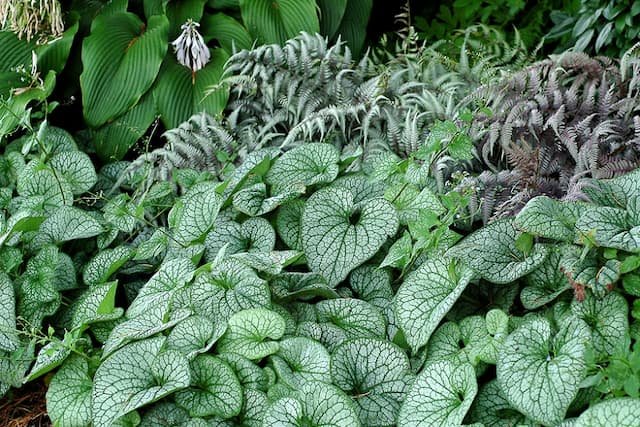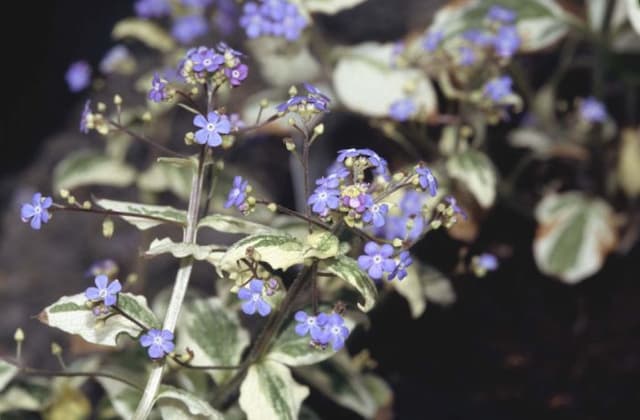Venus's Navelwort Omphalodes linifolia

ABOUT
Omphalodes linifolia, commonly known as Venus's navelwort, is an annual plant that is characterized by its delicate and slender appearance. The plant features an array of narrow, lance-shaped leaves that sprout from the stem, creating a light, feathery foliage. The leaves are generally a bright green color, giving the plant a fresh, vibrant look. During its blooming period, Venus's navelwort bears small, five-petaled flowers that are often a striking shade of blue, creating a gentle contrast against the green foliage. These flowers have a simple yet charming structure and tend to form loose clusters. The plant presents itself with a graceful and soft demeanor, which can make it an appealing addition to garden spaces that aim for a serene or wildflower garden aesthetic.
About this plant
 Names
NamesFamily
Boraginaceae
Synonyms
Venus's Navelwort, White Blue-Eyed Mary, Linifolia-flowered Omphalodes
Common names
Cynoglossum linifolium, Cynoglossum omphalodes, Omphalodes verna.
 Toxicity
ToxicityTo humans
Omphalodes linifolia, also known as Venus's navelwort, does not have a notable reputation for being toxic to humans. There is limited information regarding its toxicity, and it does not appear on most lists of poisonous plants. Therefore, there are no well-documented symptoms of poisoning from this plant. However, as with any plant not commonly regarded as edible, it is advisable to avoid ingesting parts of this plant as a precautionary measure, considering that even non-toxic plants can cause gastrointestinal discomfort or allergic reactions in some individuals.
To pets
Venus's navelwort is not widely recognized as a toxic plant for pets either. There is little to no information available on the toxic effects of Omphalodes linifolia on animals, and it is not commonly listed among plants that are known to have harmful effects on pets such as cats and dogs. However, as pets may have different sensitivities to various plant substances, it is generally recommended to keep pets from ingesting this or any other ornamental plant. If a pet were to consume Venus's navelwort, watch for signs of gastrointestinal upset or abnormal behavior, and consult with a veterinarian.
 Characteristics
CharacteristicsLife cycle
Annuals
Foliage type
Deciduous
Color of leaves
Green
Flower color
Blue
Height
1 foot (30 cm)
Spread
1 foot (30 cm)
Plant type
Herb
Hardiness zones
5
Native area
Mediterranean
Benefits
 General Benefits
General Benefits- Ornamental Value: Omphalodes linifolia, commonly known as Venus's navelwort, has delicate blue flowers and fine, textured foliage that add visual interest to garden spaces.
- Low Maintenance: Venus's navelwort is known for being easy to care for, requiring minimal attention once established in the right conditions.
- Drought Tolerance: This plant has the ability to withstand dry periods once established, making it suitable for xeriscaping or gardeners with water restrictions.
- Pollinator Attraction: The flowers of Venus's navelwort attract pollinators such as bees and butterflies, supporting local ecosystems.
- Ground Cover: Its mat-forming growth habit makes it an excellent ground cover, reducing soil erosion and suppressing weed growth.
 Medical Properties
Medical PropertiesThis plant is not used for medical purposes.
 Air-purifying Qualities
Air-purifying QualitiesThis plant is not specifically known for air purifying qualities.
 Other Uses
Other Uses- Omphalodes linifolia, commonly known as Venus's navelwort, can be used in rock gardens for its low-growing habit and delicate foliage, making it a good groundcover that adds texture and interest.
- The plant's small blue flowers add a splash of color to fairy gardens, miniature landscapes designed to create a whimsical garden feature.
- Venus's navelwort is suitable for planting in containers due to its compact size, and can be used to embellish patios or balconies.
- It can be part of a "green roof" setup, as its tolerance for dry conditions can help to insulate buildings and promote biodiversity.
- The plant can be used in craft projects, where its dainty flowers and foliage might be pressed and used in botanical art.
- Venus's navelwort may be used in corsages or as a delicate touch in floral arrangements due to its small, ornamental flowers.
- It can serve as an edging plant along walkways and borders, offering a refined appearance to garden design with its fine leaves and flowers.
- The plant can be cast in resin to create jewelry pieces like pendants or rings, showcasing its subtle beauty in handmade accessories.
- Venus's navelwort can be used in educational settings such as schools or botanical gardens to teach about plant growth habits and flower structures.
- Because of its attractive foliage and flowers, it can be used in photography, providing a natural and appealing backdrop for close-up nature shots.
Interesting Facts
 Feng Shui
Feng ShuiOmphalodes linifolia is not used in Feng Shui practice.
 Zodiac Sign Compitability
Zodiac Sign CompitabilityOmphalodes linifolia is not used in astrology practice.
 Plant Symbolism
Plant Symbolism- Delicacy: With its small and delicate flowers, Omphalodes linifolia, commonly known as Venus's navelwort, symbolizes fine and intricate beauty.
- Perseverance: Venus's navelwort persists in growing in conditions where other plants might struggle, representing the ability to endure and thrive.
- Purity: The pure white color of some Venus's navelwort blooms is often associated with innocence and purity.
- Connection: The plant's navel-like centers from which it gets its name can symbolize a connection to the core or essence of a being or concept.
 Water
WaterOmphalodes linifolia, also known as Venus's navelwort, prefers consistent moisture, but it's important not to overwater to prevent root rot. The plant should be watered when the top inch of the soil feels dry to the touch. Use a watering can to gently water the soil around the plant until it is evenly moist, not soggy, which typically means applying about 1 gallon of water per square yard every week during the growing season. During the winter rest period, reduce watering to every other week or less, depending on the dryness of the indoor air. Make sure the plant has proper drainage to avoid water stagnation around its roots.
 Light
LightVenus's navelwort thrives best in partial shade with some morning sunlight or dappled sunlight throughout the day. It is ideally placed in a spot where it receives protection from the harsh afternoon sun, which can be too intense and lead to foliage burn. East or north-facing locations are typically well-suited for providing these lighting conditions.
 Temperature
TemperatureVenus's navelwort prefers a temperate climate with ideal temperatures ranging from 50 to 72 degrees Fahrenheit. It can tolerate a short-term minimum temperature of around 30 degrees Fahrenheit but will not survive extended periods of freezing conditions. The plant enjoys cooler temperatures and may not fare well in consistently high temperatures above 80 degrees Fahrenheit.
 Pruning
PruningPruning Venus's navelwort isn't usually necessary, but it can be done to maintain a neat appearance and encourage bushier growth. Lightly trim the plant after flowering to promote a second bloom and remove any dead or damaged stems. The best time for pruning this plant is in the late spring or after its first flowering period.
 Cleaning
CleaningAs needed
 Soil
SoilOmphalodes linifolia, commonly known as Venus' navelwort, thrives in a soil mix that is well-draining and rich in organic matter. A blend of potting soil, peat, and perlite or sand works well. The pH should be slightly acidic to neutral, ranging from 5.5 to 7.0.
 Repotting
RepottingVenus' navelwort should be repotted every 2-3 years or when it outgrows its current pot. It's best to repot in spring or early summer, giving the plant time to establish before winter.
 Humidity & Misting
Humidity & MistingVenus' navelwort prefers moderate humidity levels but is tolerant of a range of conditions. Aim for humidity levels of about 40-50% for optimal growth.
 Suitable locations
Suitable locationsIndoor
Keep in sunny spot with moist, well-drained soil.
Outdoor
Plant in partial shade, water regularly, protect from frost.
Hardiness zone
5-9 USDA
 Life cycle
Life cycleOmphalodes linifolia, commonly known as Venus's navelwort, begins its life cycle with seed germination, which typically occurs in the spring when soil temperatures are adequate. The seeds develop into small seedlings with their first true leaves, initiating the vegetative growth stage where the plant focuses on leaf and stem development. As it matures, Omphalodes linifolia enters the flowering stage, usually in late spring or early summer, during which blue to violet flowers bloom, attracting pollinators for sexual reproduction. Following pollination, the plant produces fruit capsules containing seeds, which signify the reproductive stage, completing its life cycle. The seeds are dispersed by various means, including wind, water, or animal movement, and, if conditions are favorable, they will germinate to start a new life cycle. Venus's navelwort is a perennial plant, and after seed set, it will go into a period of dormancy during colder months, resuming growth the following spring.
 Propogation
PropogationPropogation time
Spring
Propogation: Omphalodes linifolia, commonly known as "Venus's navelwort", is commonly propagated through seed. The most popular method is to sow the seeds directly outdoors. The best time to do this is in spring, just after the last frost when soil temperatures are on the rise, typically around 60-70 degrees Fahrenheit (approximately 15-21 degrees Celsius). To propagate Venus's navelwort through seeds, scatter them on top of a well-drained soil mix, and lightly cover with soil. The seeds need ample sunlight to germinate, so avoid burying them deeply. Keep the soil moist but not waterlogged, and with the right conditions, germination should occur within a couple of weeks. Seedlings can be thinned to the appropriate spacing once they have a couple of sets of true leaves.









